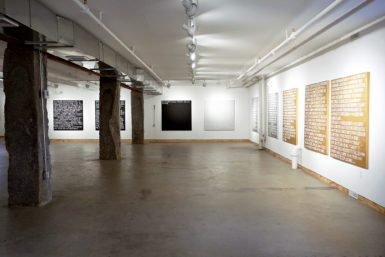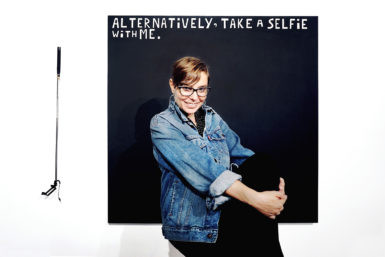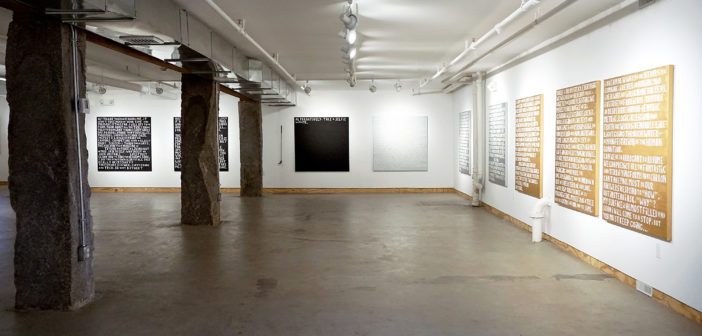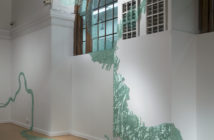Jonathan Talit recently met with Julia Csekö to discuss her solo exhibition Straight from the Heart – The Rant Series (August 6-27, 2016), made possible with the generous support of the Walter Feldman Fellowship and organized by the Arts and Business Council. It was hosted by the Piano Craft Gallery–a historic gallery space off Tremont Street, focused on promoting contemporary Boston-based artists.
Talit and Csekö struck a friendship after working together at the ICA. This interview is an extension of their numerous conversations about art.
Jonathan Talit: I thought a good place to start would be the title: Straight from the Heart – The Rant Series. What did you feel you needed to rant about?
Julia Csekö: The phrase comes from a performance created during my MFA. I melted sugar letters onto plates filled with Vodka, poured it into glasses and offered them to viewers. The first one used the phrase “straight from the heart.” But I stopped using my own phrases after a bad critique at SMFA…
JT: Yeah?
JC: Yeah, the worst I heard was that the performance was “masturbatory” and self-aggrandizing. I was writing personal things, those classic texts you send to a lover.
JT: Oh! Like “Here” or “You up?”
JC: Yes! It really pissed people off and that was not what I was going for. So I decided to use obscure philosophical quotes instead. But recently it felt like time to start writing my own text. That’s what I’m doing with these paintings. It’s all stream-of-thought.
JT: That stream-of-thought is three triptychs: each one a different color (black, silver, and gold) displaying the white of the canvas as text. Once you read them, you realize that the attitude of each triptych is distinct. How did they come to be?

"Straight from the Heart - the Rant series," solo exhibition by Julia Csekö, Piano Craft Gallery. August 2016. Courtesy of the artist.
JC: I was partially inspired to make this work while I was a Visitor Assistant at the ICA. It was a difficult job because you stood all day surrounded by art (which I love), but you’re guarding it, not experiencing it, and it’s a tense environment. But if you play it right, it becomes a fertile ground for thinking.
The first triptych is unapologetic, dealing with the reality of paying the bills as an artist. Being an artist is hard, takes stamina, but not all horrible. The second triptych dwells on “How did I get here?” I dove into a personal archeology–a term coined by professor Simone Michelin–and I found that when I was seventeen, two shows by very different artists inspired me to study art.
JT: And they were?
JC: Bispo do Rosário and Luciano Fabro. Rosário was a prolific naïf artist, committed to a mental institution for most of his life. Fabro came from the tradition of Arte Povera–rigorous, methodic, majestic!
JT: Were you attracted to any pieces in particular?
JC: Fabro has a piece where he engraved a life-size drawing of himself onto a monolithic marble cylinder, which is rolled over cacao powder, generating a print onto the cacao using the marble as the “printing plate.” The title of the piece is “Sisyphus.”
JT: So you liken your body of work to rolling a boulder up a hill?
JC: Pretty much! But the point of Fabro’s piece is that it’s not all a burden. Or, that there is beauty in that burden.
JT: Right. It’s not all black and white, like the first triptych.
JC: Yes, there are gray areas added to the narrative by the second triptych. By the silver paintings, the tone changes from “Damn this is heavy” to “I think I like rolling this boulder up the hill.” By the gold triptych, the tone is confident: "I don’t care how many times I have to roll this boulder, I fucking love doing it.”
JT: So when it says “I am the present tense of evolution” that’s the painting talking?
JC: Yes. When the paintings ask questions, it’s not just me personally asking them but also the painting stating “I need you (the viewer) in order to exist.” I’m questioning the idea that art is static. Lygia Clark, one of my earliest references, talks about this sort of call and response even if it’s an afterthought.
JT: The biggest thing that stuck out to me about the last triptych is that the whole vocabulary changes.
JC: The gold triptych presents a macro point of view “Whoa, I can see the whole planet, the galaxy, the cosmos!” The word choice responds to those different perspectives.
JT: Scale is a funny thing to talk about with these paintings because they’re all the same size, but the perspective of the “narrator” widens throughout the sequence.

Julia Csekö, "Black #3, Straight from the Heart - the Rant series," 2016, acrylic on canvas with selfie stick, 50 x 50." Courtesy of the artist.
JC: The main dilemma of our time seems to be sustainability. The gold paintings are hopeful. They hail art as an indicative of thinking past short-term necessities. Similar to basic scientific research–without which most discoveries can’t take place–art is a great way to test out ideas, accepting the lack of guarantee that any results will be achieved.
JT: The third canvas of the black triptych says, “Alternatively, take a selfie with me.” It feels like it just gives up, like “Fine, I’ll be your backdrop for a picture that you’ll never look at again if this is the best I can get.”
JC: Yes, I remind the viewer of their direct involvement. These paintings critique their own impracticality as sellable pieces of art. They are self-conscious of how hard it is to accommodate nine 50” x 50” canvases in a home. Yet, they still try to guilt trip the viewer: “Take a selfie with me,” “My very existence depends on your gaze,” “Yes, you.”
JT: That back-and-forth is the strongest thing about these paintings to me. I was constantly trying to figure out how much to participate. It actually makes me think about Facebook.

Julia Csekö, "Black #3, Straight from the Heart - the Rant series," opening night group selfie,
acrylic on canvas with selfie stick, 50 x 50." Photo courtesy of Emily Abramovich.
JC: Really?!
JT: Definitely. The whole series makes me think about Facebook statuses–the main place people voice their opinions and rant. So a lot of people can see it and participate or not participate. And there doesn’t seem to be a general “rule” on when, how or if to respond.
JC: I guess the advantage of having this text, this rant, in this form is that it’s stuck there. You can’t scroll past it.



